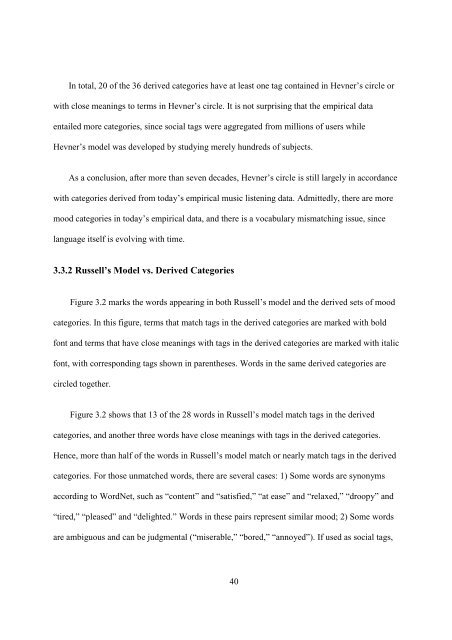improving music mood classification using lyrics, audio and social tags
improving music mood classification using lyrics, audio and social tags
improving music mood classification using lyrics, audio and social tags
Create successful ePaper yourself
Turn your PDF publications into a flip-book with our unique Google optimized e-Paper software.
In total, 20 of the 36 derived categories have at least one tag contained in Hevner’s circle or<br />
with close meanings to terms in Hevner’s circle. It is not surprising that the empirical data<br />
entailed more categories, since <strong>social</strong> <strong>tags</strong> were aggregated from millions of users while<br />
Hevner’s model was developed by studying merely hundreds of subjects.<br />
As a conclusion, after more than seven decades, Hevner’s circle is still largely in accordance<br />
with categories derived from today’s empirical <strong>music</strong> listening data. Admittedly, there are more<br />
<strong>mood</strong> categories in today’s empirical data, <strong>and</strong> there is a vocabulary mismatching issue, since<br />
language itself is evolving with time.<br />
3.3.2 Russell’s Model vs. Derived Categories<br />
Figure 3.2 marks the words appearing in both Russell’s model <strong>and</strong> the derived sets of <strong>mood</strong><br />
categories. In this figure, terms that match <strong>tags</strong> in the derived categories are marked with bold<br />
font <strong>and</strong> terms that have close meanings with <strong>tags</strong> in the derived categories are marked with italic<br />
font, with corresponding <strong>tags</strong> shown in parentheses. Words in the same derived categories are<br />
circled together.<br />
Figure 3.2 shows that 13 of the 28 words in Russell’s model match <strong>tags</strong> in the derived<br />
categories, <strong>and</strong> another three words have close meanings with <strong>tags</strong> in the derived categories.<br />
Hence, more than half of the words in Russell’s model match or nearly match <strong>tags</strong> in the derived<br />
categories. For those unmatched words, there are several cases: 1) Some words are synonyms<br />
according to WordNet, such as “content” <strong>and</strong> “satisfied,” “at ease” <strong>and</strong> “relaxed,” “droopy” <strong>and</strong><br />
“tired,” “pleased” <strong>and</strong> “delighted.” Words in these pairs represent similar <strong>mood</strong>; 2) Some words<br />
are ambiguous <strong>and</strong> can be judgmental (“miserable,” “bored,” “annoyed”). If used as <strong>social</strong> <strong>tags</strong>,<br />
40
















